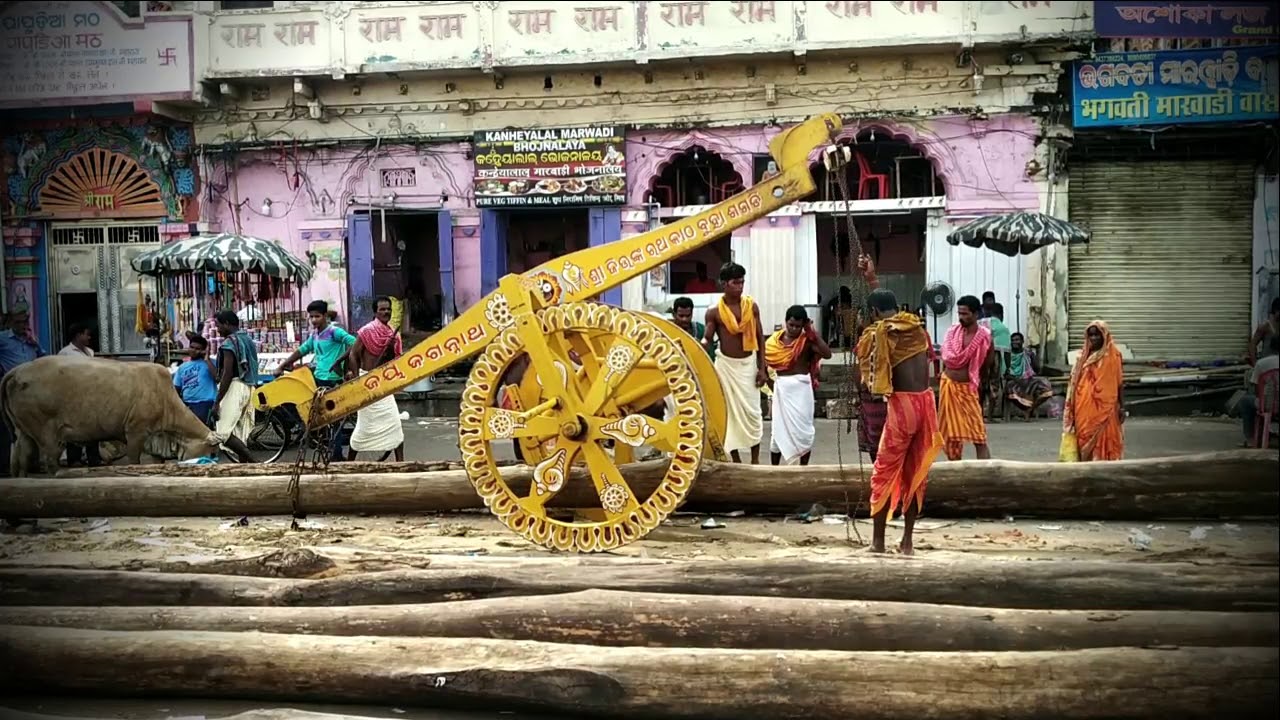


Members of the Shree Jagannath Temple Managing Committee performed traditional rituals as the log sawing began at the Forest Department's sawmill in Cuttack. This marks the start of "Katha Chirat" for the upcoming Ratha Yatra of Lord Jagannath, which takes place on the auspicious occasion of Shri Ram Navami. The logs will be used for the construction of chariots for the Holy Trinity and the process will continue daily from 6am to 9am. This has been a longstanding tradition and is an important part of the preparations for the Ratha Yatra.
Ram Navami and the Katha Chirat Ritual for Ratha Yatra
Ram Navami, a significant festival in Hinduism, marks the birth of Lord Rama. Traditionally, the Katha Chirat (log sawing) ritual for the upcoming Ratha Yatra of Lord Jagannath is also performed on this auspicious day.
Background and Significance
The Ratha Yatra, a grand chariot festival, is celebrated annually in Puri, Odisha, to honor Lord Jagannath, Lord Balabhadra, and Devi Subhadra. The construction of the three chariots for the Holy Trinity is a crucial part of the festival preparations.
According to tradition, the logs used for the chariots must be sourced from specific types of trees (Daru and Dhaura) that are considered sacred. The Katha Chirat ritual marks the beginning of the process of obtaining and preparing these logs.
Traditional Rituals and Process
Members of the Shree Jagannath Temple Managing Committee perform the traditional rituals at the Forest Department's sawmill in Cuttack. The Chief Minister of Odisha is also present to witness the occasion.
The log sawing is carried out daily between 6am and 9am, starting on Ram Navami. The logs are sawn into planks, which are then used to construct the three chariots. This process typically takes around three months to complete.
Historical Significance
The Katha Chirat ritual has been a long-standing tradition in Puri. It is believed that the practice dates back to the 6th century, when the original temple of Lord Jagannath was built.
Over the centuries, the ritual has evolved and become an integral part of the Ratha Yatra celebrations. It signifies the beginning of the sacred journey and the symbolic construction of the chariots that will carry the deities during the festival.
Top 5 FAQs and Answers
Q: What is the significance of Ram Navami in the context of Ratha Yatra? A: Ram Navami is the traditional day for the commencement of the Katha Chirat ritual, which marks the start of the chariot construction process for Ratha Yatra.
Q: Why are specific types of trees used for the chariot construction? A: The Daru and Dhaura trees are considered sacred and are believed to possess special properties that make them suitable for the construction of the divine chariots.
Q: How long does the log sawing process take? A: The log sawing and preparation of the planks typically takes around three months to complete.
Q: Who performs the Katha Chirat rituals? A: The rituals are performed by members of the Shree Jagannath Temple Managing Committee, along with the Chief Minister of Odisha.
Q: Is the Katha Chirat ritual the same as the Ratha Yatra festival? A: No, the Katha Chirat ritual is a specific event that marks the beginning of the chariot construction process, while the Ratha Yatra festival is a grand celebration centered around the pulling of the chariots by devotees.

Diwali, the festival of lights, is a celebration of good over evil and light over darkness. This festival is rooted in a rich history of mythological connections, with Hindus commemorating Lord Rama and his victory over the demon king Ravana. However, Diwali is not limited to just one faith - it is celebrated across beliefs and traditions, including Jains, Sikhs, and Newar Buddhists. Festivities and celebrations during this time include illuminations, rituals, feasting, and community gatherings, making it a time of joy, renewal, and gratitude.

Maharashtra Chief Minister Devendra Fadnavis honors the brave officers who sacrificed their lives in an ambush laid by Chinese troops in Ladakh. He pays respects at the martyrs' memorial on Police Commemoration Day, highlighting their inspiration for courage and integrity. The event is observed annually to remember the 10 valiant policemen who lost their lives in the line of duty.

Prime Minister Narendra Modi marked Diwali by joining the armed forces aboard INS Vikrant, India’s indigenous aircraft carrier. A cultural programme on the vessel, showcasing the creative talents of naval personnel, left a lasting impression on the PM. He took to Twitter to express his admiration for the emotional and artistic depth within the armed forces, highlighting the symbolic power of Diwali – light triumphing over darkness – as a reflection of India’s growing strength.

On the sacred occasion of Diwali and the Hindu New Year, His Holiness Mahant Swami Maharaj extended blessings to BAPS followers worldwide. In a handwritten letter, he encouraged individuals to celebrate a Diwali that glows within the soul and radiates throughout society, with lamps of service, humility, and righteousness. He prayed for universal well-being in the New Year and reminded devotees to ignite the flame of virtue in their homes, not just through lighting lamps but also through acts of love, compassion, and service.

This upcoming Diwali in 2025, Indians and Hindu communities around the world will be celebrating amidst a digital revolution. With virtual parties, online shopping, and eco-friendly decorations, technology is transforming the age-old festival into a modern extravaganza. Social media influencers have played a crucial role in promoting the digital celebration, along with the rising environmental consciousness reflected in the use of biodegradable diyas and organic rangoli colours. This 'digital Diwali' not only brings a new level of convenience but also promotes creativity and sustainability.

In 2025, Hindus will be able to celebrate both Narak Chaturdashi and Diwali together on the same day. This coincidence marks a rare event, with the two festivals usually being observed a day apart. Narak Chaturdashi holds special significance in the five-day Diwali festival, and this year, it will be celebrated on Monday, October 20. Hindus believe that lighting the Yam Deep diya during this festival will bring protection from untimely death and negativity.

An explosion at an open cast coal mine in Chhattisgarh's Manendragarh has left at least three workers injured, including two women. According to initial reports, the explosion occurred while workers were preparing for a routine blasting operation. A probe has been launched to determine the cause of the incident, as authorities work to ensure safety measures are in place to prevent future mishaps.

As India celebrates Diwali today, devotees are preparing to perform the auspicious Lakshmi Puja to seek the blessings of the goddess of wealth and prosperity. The most auspicious timings for the puja have been revealed, falling between 7:25 pm and 8:31 pm. This article provides a city-wise breakdown of the muhurat and also highlights other important details for performing the puja on this special day.

Narak Chaturdashi, also known as Chhoti Diwali, is more than just a fancy decoration ritual. It holds deep significance in Hindu beliefs, honoring Lord Yama and seeking protection from negative energies in the coming year. The arrangement and number of diyas have symbolic meanings and a specific auspicious time for lighting them on this particular day. The act of lighting diyas on Narak Chaturdashi is a powerful chain of emotions that brings forth resilience, wisdom, and inner strength, leading to harmony and auspiciousness in the household.

On the occasion of Deepotsav, Ayodhya made history by setting two new Guinness World Records - lighting over 26 lakh diyas and hosting the largest-ever Saryu aarti. The event was organized by the Uttar Pradesh Tourism Department and the Ayodhya District Administration, with the participation of over 30,000 volunteers. The Guinness World Records officials commended the efforts and stated that it was an honor to witness such a grand and spectacular display. The city of Ayodhya also celebrated Diwali with a drone show and a Ram Leela performance, making the event even more special.